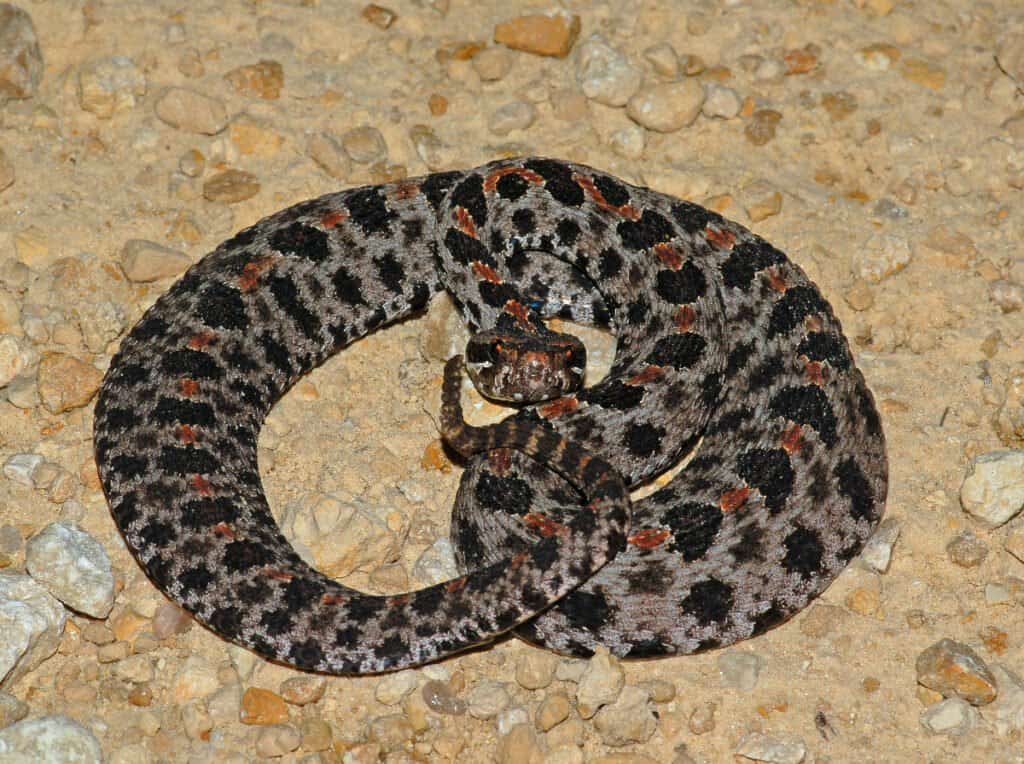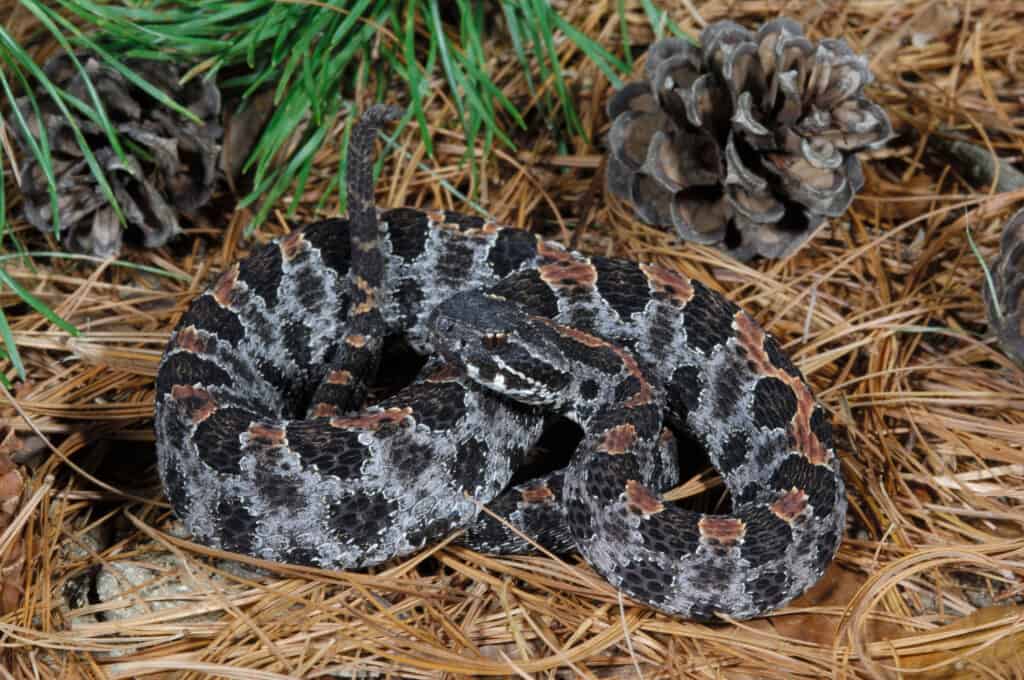There are a lot of snakes in Mississippi—over 50 different species! In the southern regions of the state, you can see snakes all year long. In the northern regions, on the other hand, many snakes brumate during the winter. Snakes emerge from their dens around March or April as it gets warmer, and often bask in the sun on rocks. Throughout Mississippi you are likely to see many black racer snakes, ribbon snakes, water snakes, and speckled king snakes. Most of the snakes here are completely harmless to humans, but there are six venomous species to watch out for. These include cottonmouth snakes, copperhead snakes, coral snakes, and rattlesnakes. Let’s take a look at the four types of rattlesnakes in Mississippi.
Western Pygmy Rattlesnake

Western pygmy rattlesnakes have heavy, wide bodies that are under 2 feet long.
©Gerald A. DeBoer/Shutterstock.com
| Western Pygmy Rattlesnake | |
|---|---|
| Range | Scattered throughout Mississippi |
| Length | 16-25 inches |
The western pygmy rattlesnake is a subspecies of the pygmy rattlesnake. This snake lives in scattered populations throughout Mississippi. However, it is much less common along the western edge of the state near the Mississippi River. Western pygmy rattlesnakes prefer wooded and forested areas, as well as edges of marshes and swamps. However, these rattlesnakes are not very common in Mississippi and rarely encounter humans. Pygmy rattlesnakes are also shy and typically nonaggressive, avoiding people as much as possible. These snakes eat mice, ground-dwelling birds, lizards, frogs, and other smaller snakes.
Western pygmy rattlesnakes are a small species of rattlesnake, growing only 16-25 inches in length. These snakes have such a tiny rattle at the end of their tails that sometimes you can barely hear it! Western pygmy rattlesnakes do have thick bodies, however, that are typically tan, gray, or gray, brown in color. Rows of dark blotches line their backs and sides, and some individuals will also have an orange stripe along their spine between the blotches. There is a dark stripe running from each eye to the back of the snake’s mouth as well.
Dusky Pygmy Rattlesnake

Pygmy rattlesnakes are also sometimes called “ground rattlers.”
©Breck P. Kent/Shutterstock.com
| Dusky Pygmy Rattlesnake | |
|---|---|
| Range | Eastern Half & Southwestern Corner of Mississippi |
| Length | 16-26 inches |
The dusky pygmy rattlesnake is another subspecies of the pygmy rattlesnake. These snakes are scattered throughout the eastern half and southwestern corner of Mississippi. Dusky pygmy rattlesnakes prefer habitats like pine forests, palmetto flatwoods, and the edges of ponds or marshes. However, the dusky pygmy rattlesnake is shy and rarely encounters humans. These snakes have a cytotoxic venom that damages tissue and stops blood flow. Due to their small size, they cannot inject a lot of venom into a single bite, but they are still dangerous and should be left alone.
Dusky pygmy rattlesnakes measure between 16-26 inches in length with small, slender bodies and tiny rattles. These snakes are typically gray with dark blotches running along their backs, as well as dark spots and stippling patterns on their sides. They also have a dark stripe that runs from each eye to the back of their mouths. Young dusky pygmy rattlesnakes look a lot like adult snakes, except that the tip of their tail is yellow. When hunting, they twitch their yellow tail tip to lure in frogs and lizards to eat.
Timber Rattlesnake / Canebrake Rattlesnake

Timber rattlesnakes are the most venomous snake in the U.S.
©Frode Jacobsen/Shutterstock.com
| Timber Rattlesnake | |
|---|---|
| Range | All of Mississippi |
| Length | 36-54 inches |
In Mississippi, timber rattlesnakes are most frequently called “timber rattlers”. The timber rattlesnake lives all throughout Mississippi. However, this snake is not very common in the southeastern corner of the state or along the Gulf Coast. Timber rattlesnakes live in agricultural fields, forests, river bottoms and swampy areas. These snakes were once quite abundant throughout Mississippi, but their populations are quickly declining due to habitat loss and human violence. In addition, these snakes only reproduce once every three years.
Timber rattlesnakes have extremely toxic venom, but most bites in Mississippi occur because the person was persecuting the snake or trying to capture it. In general, if you leave timber rattlesnakes alone, they pose very little harm to humans. These snakes are surprisingly calm and can be slow to defend themselves. Most timber rattlesnakes will choose to remain quiet and unseen, or slither away if possible.
Timber rattlesnakes have heavy bodies covered in keeled or ridged scales. On average, timber rattlesnakes grow between 36-54 inches in length. These snakes are gray, tan, brown, or a pinkish color, with dark, wavy bands along the length of their bodies that end in a velvety-black tail and a large keratin rattle. Some snakes (especially in the southern and western regions of Mississippi) also have a rust or orange-colored stripe running down their backs. They may also have a dark stripe running from behind each eye to the back of their mouths. The colors and patterns of these snakes help them to camouflage as they slither along the ground and through vegetation. However, snakes in various regions of Mississippi may have slightly different colors and patterns.
Eastern Diamondback Rattlesnake

Eastern diamondback rattlesnakes’ pattern often fades towards their tail.
©Chase D’animulls/Shutterstock.com
| Eastern Diamondback Rattlesnake | |
|---|---|
| Range | Southern 1/3 of Mississippi |
| Length | 48-66 inches |
The eastern diamondback rattlesnake lives in the southern 1/3 of Mississippi. These snakes are not very good climbers. They spend most of their time on the ground or in hollow tree stumps, caves, crevices, and dens. Eastern diamondback rattlesnakes were once very common in many of the longleaf pine forests of Mississippi, but their numbers have decreased significantly due to habitat loss, road mortalities, and human persecution. Because of this, it is very rare to see an eastern diamondback rattlesnake in Mississippi.
Eastern diamondback rattlesnakes are the largest venomous snakes in Mississippi, averaging between 48-66 inches in length. They are the only snakes in Mississippi and most of the southeastern United States that have a distinct diamond pattern, making them fairly easy to identify. However, their colors and patterns offer excellent camouflage, especially when they hide in grasses and shrubs. Eastern diamondback rattlesnakes are tan or brown, with dark diamond-shaped markings running down the length of their bodies. Each diamond marking has a light-colored outline, but most of their colors fade to a much lighter shade as they get closer to the snake’s tail. The snake’s tail has black bands near its large, prominent rattle.
Despite its large and bulky appearance, the eastern diamondback rattlesnake is typically laid back and not very aggressive. Often these snakes will choose to stay quiet and hide rather than rattle or attack. When threatened, however, an eastern diamondback rattlesnake may vibrate its tail and hiss loudly. If the threat is close enough and the snake feels it is in danger, it will strike.
The photo featured at the top of this post is © iStock.com/Wide-River-Rick
Discover the "Monster" Snake 5X Bigger than an Anaconda
Every day A-Z Animals sends out some of the most incredible facts in the world from our free newsletter. Want to discover the 10 most beautiful snakes in the world, a "snake island" where you're never more than 3 feet from danger, or a "monster" snake 5X larger than an anaconda? Then sign up right now and you'll start receiving our daily newsletter absolutely free.
Thank you for reading! Have some feedback for us? Contact the AZ Animals editorial team.






